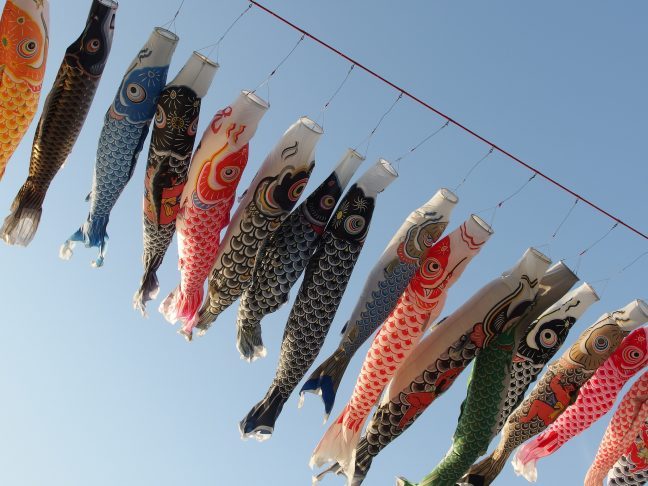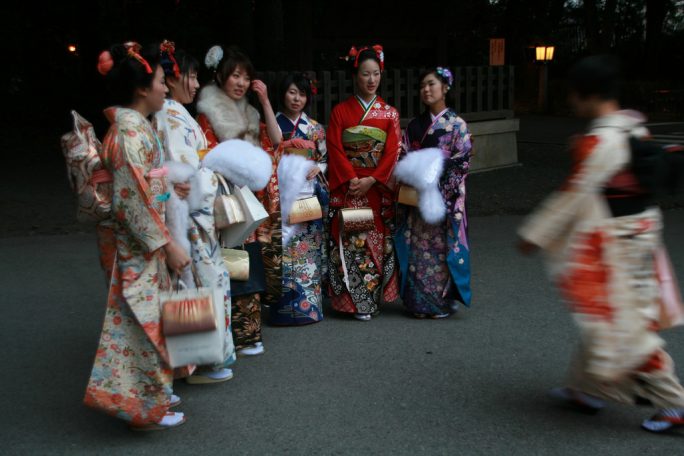Three fascinating Japanese holidays (and how they are celebrated)

Known for its multifaceted culture and amusing subcultures, Japan has a long list of national holidays rooted in its rich history, traditions, values and religious beliefs. While most of the youth are highly influenced by the west, older generations that make up over 30% of the population, still adhere to traditional customs and practices. Here are three Japanese public holidays that celebrate its people from different life stages:
Children’s Day (May)
A festive holiday that also honors parenthood, Children’s Day (Kodomo no Hi) is dedicated to the growth and happiness of children across Japan. There are many traditions and customary practices observed during this holiday. Colorful carp-shaped windsocks or koinobori that symbolize perseverance and represent a healthy childhood are hung outside homes and temples. The meaning of koinobori stems from an old Chinese legend, where a carp steadfastly swims against a strong current to become a dragon. On this day, Japanese kids look adorable wearing traditional costumes like yukata (light kimono) for girls and hakama or the Samurai costume for boys.

Image by Guilhem Vellut via Flickr under CC
At home, parents display an expensive set of Samurai armor, a symbol of strength and nobility, and Kintaro dolls that signify the extraordinary strength of Kintaro, a young warrior from a Japanese legend. And of course, no holiday is complete without eating popular treats like Kashiwa mochi, rice balls with sweet bean paste filling, and chimaki, a delicacy made of arrowroot rice cakes, dango, and corn wrapped in bamboo leaves. For some families, it’s customary to visit the Children’s Peace Monument in Hiroshima.
Coming of Age Day (January)
Annually celebrated on the second Monday of January, Coming of Age Day (Seijin No Hi) is a rite of passage that celebrates a young Japanese person’s transition into adulthood. Unlike in other countries, legal adulthood in Japan starts at 20, instead of 18. Upon reaching this age, Japanese adults have the legal right to vote in the elections, purchase and consume alcoholic drinks, and smoke tobacco products. Some parents have turned into
more creative ways to congratulate and warn their child of their responsibilities as an adult, too.

Image by Gene Jackson via Flickr under CC
On Seijin No Hi, youths attend a special ceremony at the city hall or other government office and visit the local shrine for good luck and to pay respects to local ancestors. Young women wear an expensive kimono called a furisode and a pair of slippers called zori. Traditionally, men wear a special pair of celebratory pants called hakama, but now, many of them prefer wearing suits.
As this day marks the celebration of independence and self-reliance, Japan’s newest adults can also enjoy this once-in-a-lifetime occasion with their friends however they wish – by going to an izakaya, attending a concert, and even by riding a rollercoaster.
Respect for the Aged Day (September)
With Japan having the highest healthy life expectancy in the world, it’s only fitting to pay homage to the elderly citizens for their wisdom, contributions, and longevity. In 1947, Respect for the Aged Day (Keiro No Hi) originated from Nomadani-Mura in Hyogo prefecture and by 1966, it was officially recognized by the national government as a public holiday. In recent years, it has become a larger, busier holiday due to the country’s growing aging population.
Like the Chinese that value filial piety, the Japanese take this time to show their gratitude to their parents and grandparents by visiting their homes and bringing them gifts in red, the symbolic color of the rising sun and good fortune. The elderly also enjoy free Keiro No Hi lunches from restaurants and o-bento (lunch boxes) from friends and neighbors. Town centers and retirement facilities hold keirokai shows with dances and songs performed by younger people and school children to entertain the wisest, most respected members of society. Finally, for those who prefer to stay home, most shows on national television feature admirable and noteworthy senior citizens, as well as centenarians sharing their secrets to longevity.
What are the most fascinating national holidays in your country? Share them with us!


